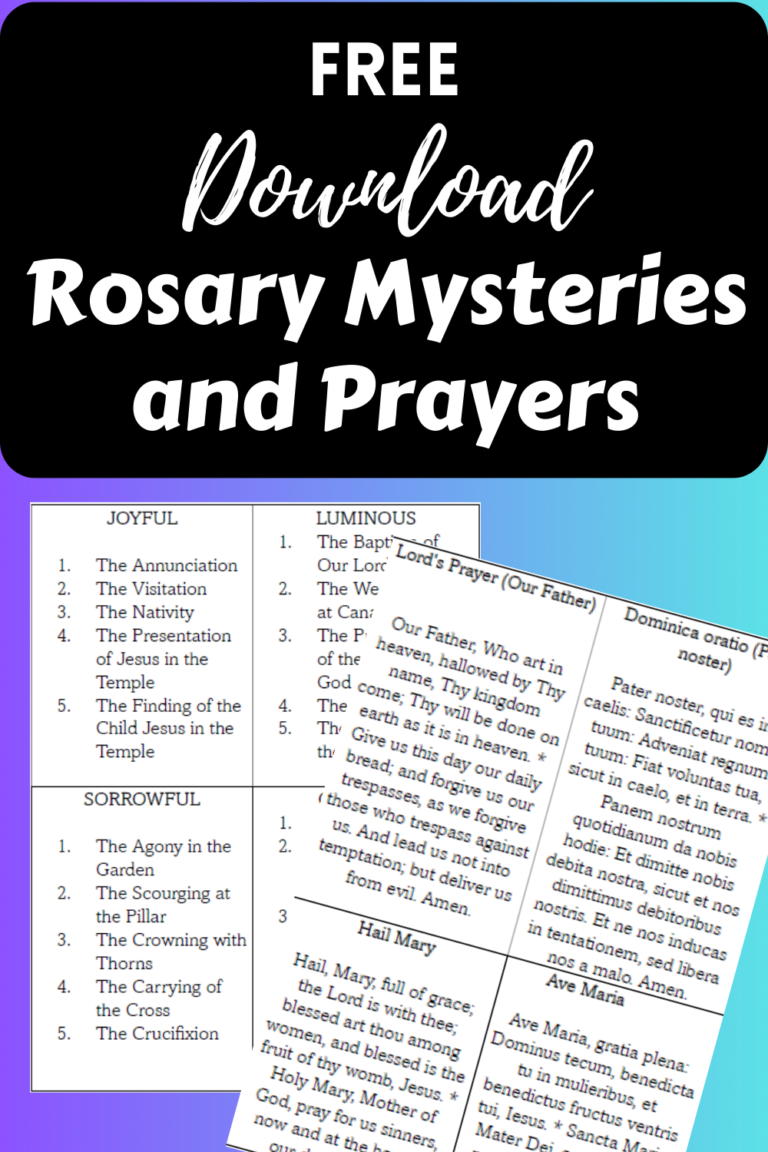Sharing is caring!
A guide for beginners!
Many Catholics have rosary beads hanging on their rearview car mirror or have fond memories of a holy grandmother diligently praying her beads. It seems like a good idea to pray the holy rosary, but how do you make sense of all of those decades, mysteries and Hail Marys? How do you pray the rosary? It may take some time to get a grasp on how to pray it, but your efforts will be fruitful!
Today, I will discuss:
- Where the Holy Rosary came from
- The Different Mysteries
- The 3 main parts of the rosary that you will pray
- How to get started praying
- How to make a good habit of praying the rosary often (hopefully daily)
- How to get back on track if you are struggling to pray the rosary
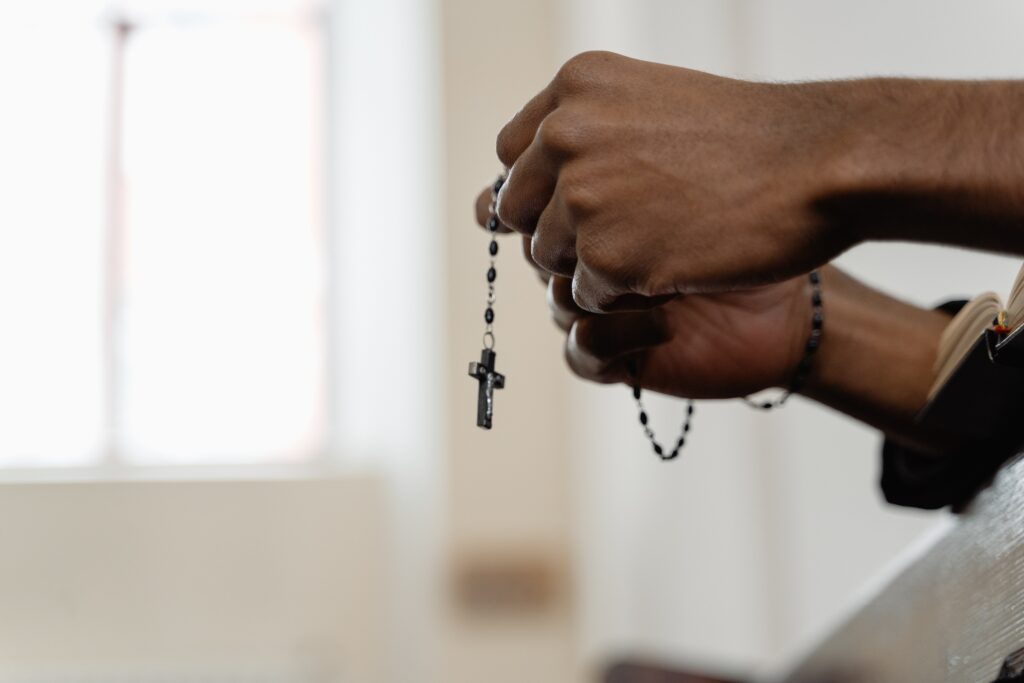
Where does the rosary come from?
In thirteenth century France and Germany, a group called the Cathars were spreading errors about Jesus Christ and the bible. For example, they taught of a “good god” of the New Testament, and an “evil god” of the Old Testament. They taught that Jesus did not assume a human body and that the entire material world was evil. Many people followed them because they looked very pious and disciplined due to their strict practices of chastity, poverty, and charity.
At the time, the Catholic church had many corrupt clergy, so the Cathars numbers grew and grew. A Catholic bishop then asked St. Dominic Guzman to start a new order of disciplined, pious preachers to teach the people the true faith – the Catholic faith.
St. Dominic traveled among the heretics and taught them about the Incarnation, Redemption and the Eternal afterlife. During his ministry, Our Blessed Mother appeared to him and instructed him in a new method of prayer that integrated the Gospel mysteries. Integrating the Gospels within the prayer was meant to teach and evangelize the truths of Jesus’s life and of the Catholic faith. That prayer is what we now know as the rosary.
He would preach a mystery and then taught them to recite 10 Hail Marys (or, 1 decade).
The evolution of the Holy Rosary
The rosary evolved over the years after St. Dominic started spreading the devotion. In the early church, it was the custom of monks to pray the 150 psalms daily. Most of the laity, however, could not read or write at the time. Learning the psalms would be difficult for them.
Eventually, the laity were encouraged to pray 150 Aves (or 150 Hail Marys) since this was much easier to learn. The first part of the Hail Mary is found in scripture:
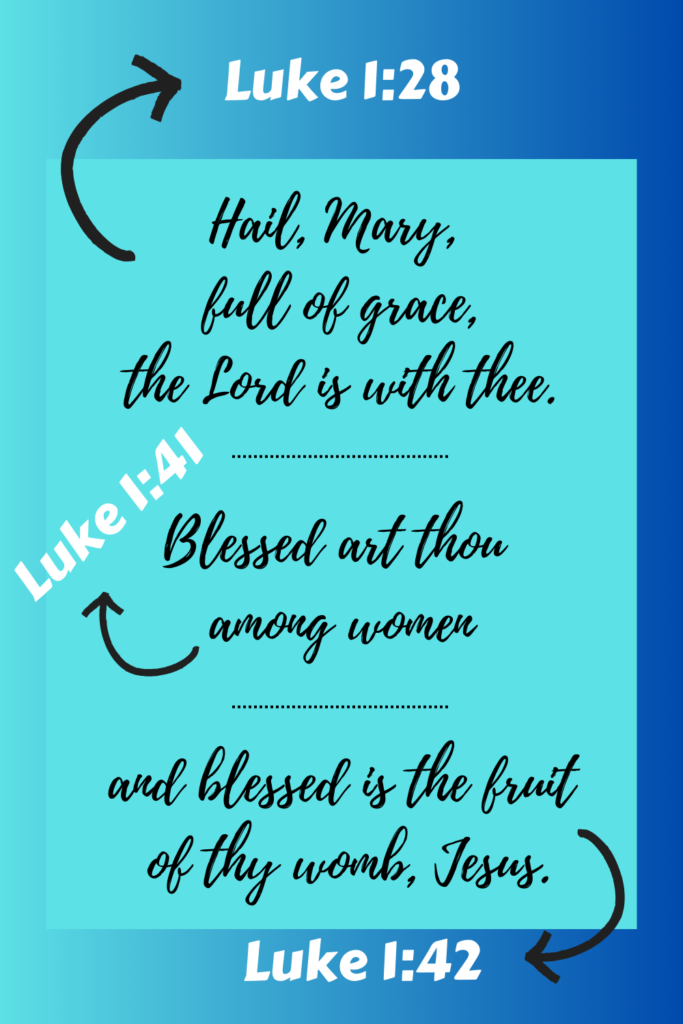
The 150 Aves came to be known as “Our Lady’s Psalter.” Later, the 150 Aves were broken up by praying an Our Father at the beginning of each decade. This made it easier to keep track. Over time, more prayers were added, and the rosary and mysteries became more formalized over the years. The order and prayers vary among different countries and cultures, but the sets of 1 Our Father followed by 10 Hail Marys is always included.
Mysteries of the Rosary
The rosary “mysteries” refer to different important events in the life of Our Lord, Jesus Christ. The purpose of the mysteries is to meditate on them and think about them while you pray the familiar prayers of the Hail Mary and the Our Father. Contemplating the mysteries of Jesus’s life allows us to encounter and know Him. The rosary is a prayer to Our Lady to ask her to bring us closer to her Son.
The answers to many difficulties and questions in my life have been answered for me while praying the rosary. Your faithfulness and perseverance will always be rewarded.
Originally, there were three sets of mysteries that covered 15 events in Jesus’s life from His birth, through His death and resurrection, and including the Assumption and Coronation of the Blessed Mother. These were the Joyful, Sorrowful, and Glorious mysteries. Each set contains 5 mysteries, so when these were prayed in full, this totaled 150 Aves (or 150 Hail Marys) which beautifully matched the number of Psalms (there are 150 Pslams) prayed by the monks in the early church.
In 2002, St. John Paul II added another set of mysteries called the Luminous mysteries. He did this to re-invigorate and encourage the faithful’s devotion to the Holy Rosary. He also wrote an encyclical entitles Rosarium Virginis Mariae. Now, the full rosary consists of 4 sets of mysteries that contain 5 mysteries in each set.
When the mysteries are prayed in order, they present Christ’s life in chronological order. Here is a brief outline of each set and the mysteries within:
Joyful Mysteries
- The Annunciation
- The Visitation
- The Nativity
- The Presentation of Jesus in the Tempe
- The Finding of the Child Jesus in the Temple
Luminous Mysteries (Added by St. John Paul II in 2002)
The Luminous mysteries are about Our Lord’s adult life – specifically His public ministry. The 5 Luminous mysteries are:
- The Baptism of Our Lord in the Jordan
- The Wedding at Cana
- The Transfiguration
- The Proclamation of the Kingdom of God
- The Institution of the Eucharist
Sorrowful Mysteries
- The Agony in the Gardon
- The Scourging at the Pillar
- The Crowning with Thorns
- The Carrying of the Cross
- The Crucifixion
Glorious Mysteries
The Glorious mysteries include the Glorious Resurrection of Our Lord through the Coronation of Our Lady. The 5 Glorious mysteries are:
- The Resurrection
- The Ascension of Our Lord
- The Descent of the Holy Spirit
- The Assumption of Our Blessed Mother into Heaven
- The Coronation of Our Blessed Mother
How do you pray the different parts of the holy rosary?
Now, let’s get praying! The rosary consists of 3 main parts:
- The Opening Prayers
- The 5 Decades
- The Closing Prayers
Simple, right? Once you understand these 3 sections, praying the rosary will make so much sense.
Part 1: Intentions and opening prayers
Whether you are praying the rosary by yourself or with others, it is customary to begin by mentioning your prayer intentions. Alone, you can simply call them to mind. In a group, you may wish to go around the group and ask each person to mention their intentions. It is powerful knowing exactly what intentions you are praying for.
You may also offer your rosary for a specific person or intention. Examples of specific intentions are “for the end of abortion,” “for my deceased relative _____,” or for “the healing of _______.”
In our family, we keep all of our birthday, Christmas cards, and notes in a box by our home altar. Every night, our children read who the next card is from and we offer our nightly rosary this person or family. You can read more about praying the rosary with kids here!
Once your intentions have been mentioned or called to mind, you are ready to begin the rosary prayers. The opening prayers will be prayed by touching the crucifix, then single bead after the crucifix, then 3 beads following the single bead, and then ending with the space between the 3 beads and next single bead.
- While holding the crucifix, touch it to your forehead, chest, then shoulders making the Sign of the Cross. You may also with to reverently kiss the crucifix. Then, pray the Apostles’ Creed.
- On the first single bead, pray the Our Father.
- On the next 3 beads, pray the Hail Mary (one for each opening bead). Before beginning this set, say,” For an increase in faith, hope and charity.” This is to pray for an increase in these 3 virtues.
- On the space in between the last Hail Mary that you prayer but before the next single bead, pray a Glory Be. The Glory Be is prayed in the SPACE between beads, so just hold onto the chain or string between the last Hail Mary and next single bead as you say the Glory Be. In other words, there is not Glory Be bead.

Part 2: The 5 Decades
After the final Glory Be of the opening prayers, you will begin the first mystery. First, you should announce or call to mind the mystery. For example, if you are praying the Joyful Mysteries, you would say, “The first Joyful Mystery is the Annunciation.”
As you pray, make sure to contemplate this part of Our Lord’s life. After you have announced the mystery, you will say 1 Our Father on the individual bead before the medal.
Then, you will skip over the medal and say a Hail Mary for each of the next 10 beads. After the 10th Hail Mary, you will hold the chain or rope after the last Hail Mary bead and say a Glory Be AND the Fatima Prayer. You have now completed one mystery!
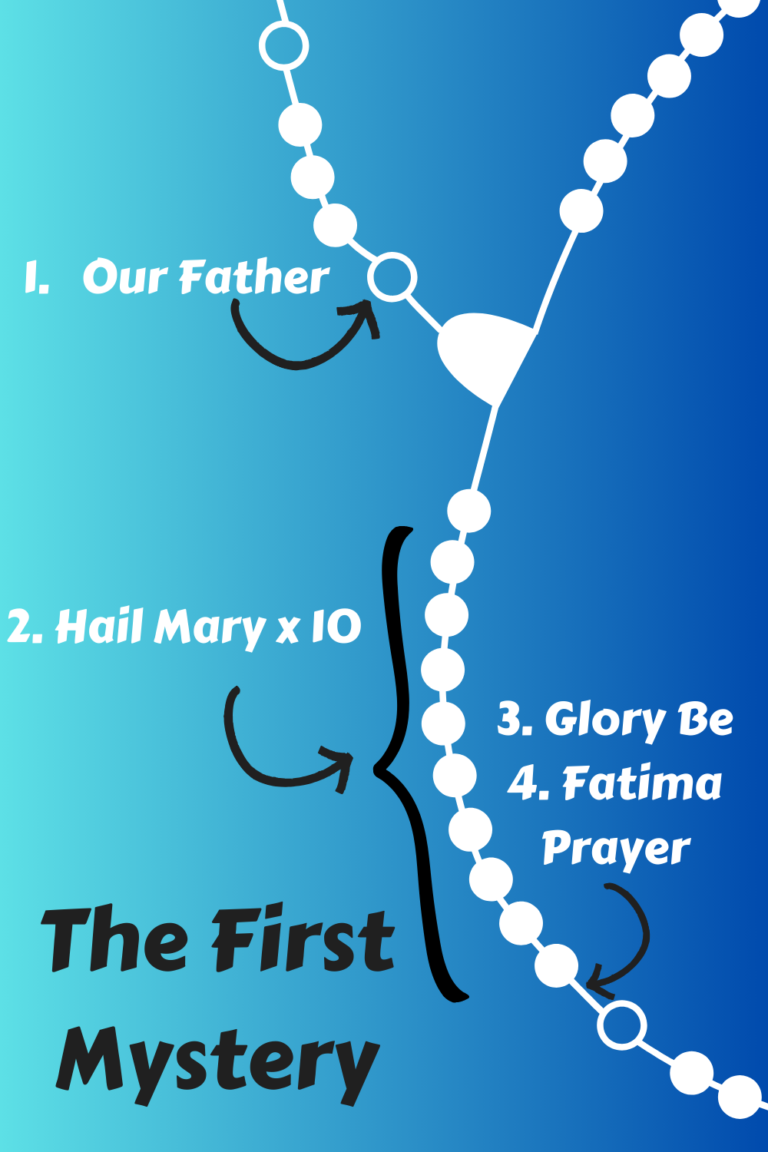
The next 4 mysteries will follow the same as the first. Begin each one by announcing the mystery to be meditated on. The, pray 10 Hail Marys, followed by a Glory Be and Fatima Prayer.
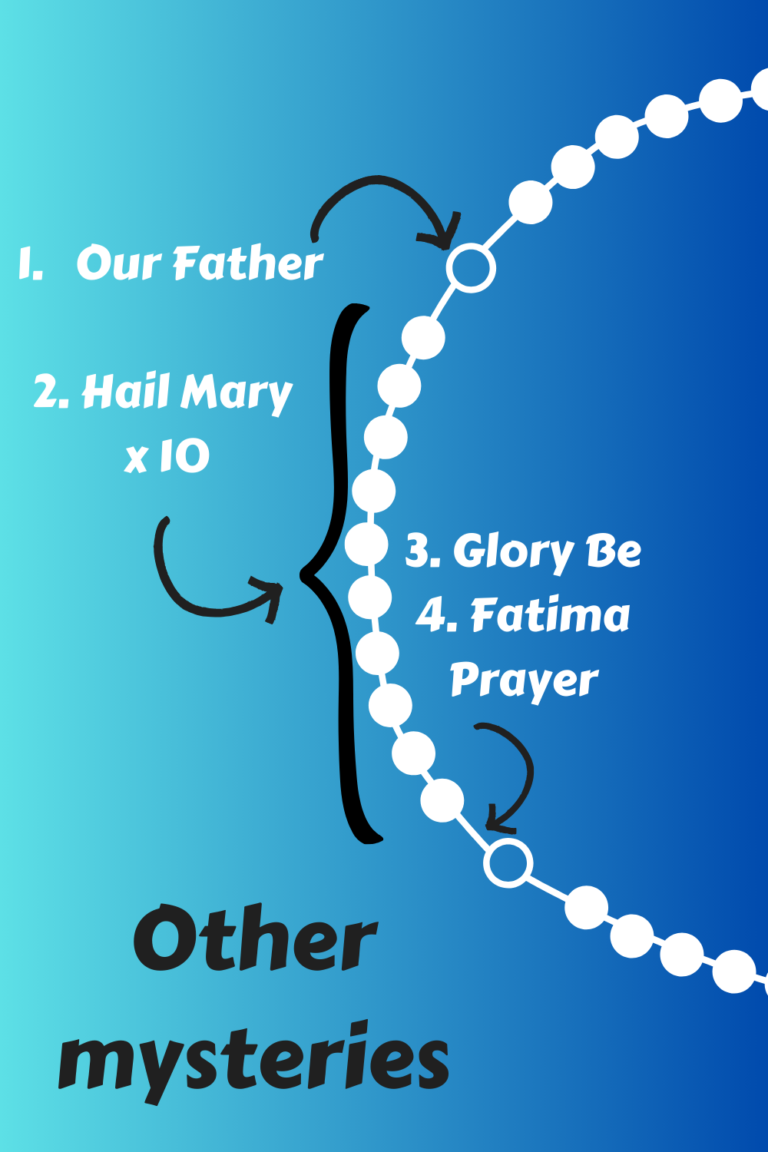
Part 3: Closing Prayers
After you have prayed 5 decades, now it is time for the closing prayers. When you get around the rosary, you will reach the medal. Holding the medal, you will say the Hail Holy Queen prayer and The Rosary Prayer.
Finally, you will hold the crucifix and make the Sign of the Cross just as you did at the beginning. And you are finished!
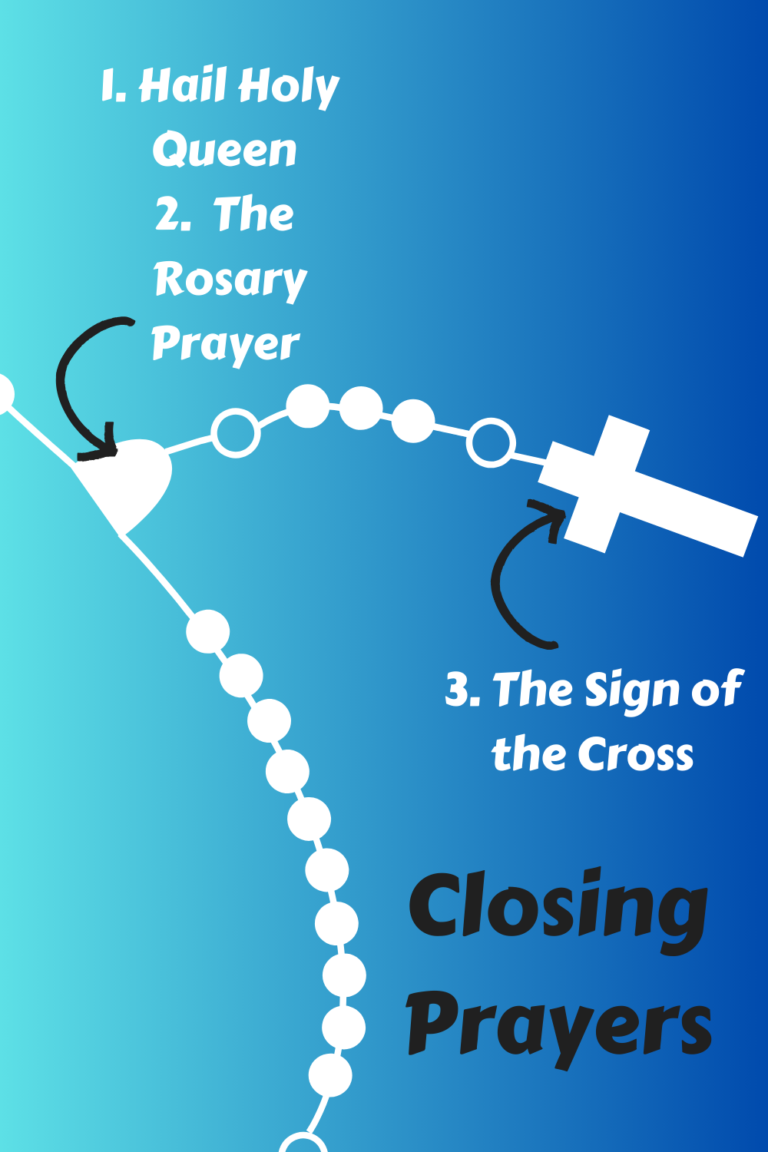
Start praying the rosary
Now that you understand the logistics of praying the rosary, it’s time to start praying it! It takes about 15-20 minutes to pray an entire rosary, but can sometimes take longer, especially if you are really listening deeply to Our Lord and what He is telling you. This is the biggest gift!
All you need to start praying the rosary is a rosary! You can use your fingers, but I find it much easier to keep track and focus with a physical rosary to keep my place.
Making a habit of praying the holy rosary
Take a look at your day and find a place when you can spare 30 minutes to pray the rosary. If this is too much to begin with, just start small and find a 10 minute block to pray 1 decade. You can always increase from there.
Perhaps you can pray the rosary right when you wake up. This is a wonderful way to start your day! Or, right before bed, or right after dinner as a family. Many parishes have groups that pray the rosary after daily Mass or on a certain night during the week.
During Lent or Advent you could make a commitment to praying the rosary as a special devotion for those seasons. Or, simply mark on your calendar or planner everyday that you pray so that you can see your good progress!
How to overcome struggles when praying the rosary
What do you do if you were on an amazing rosary streak and then you stop? Just start again! Set am alarm on your phone to remind you that it’s time to pray. We set reminders for doctors and hair appointments, and it’s even more important to give time to Our Lord in prayer.
Ask Our Lord and Our Lady to help you in your struggles.
Ave Maria!
Hopefully this post has given you some clarity on praying the rosary! It is a powerful spiritual weapon, and it is so important to pray it faithfully and consistently.
Sharing is caring!

